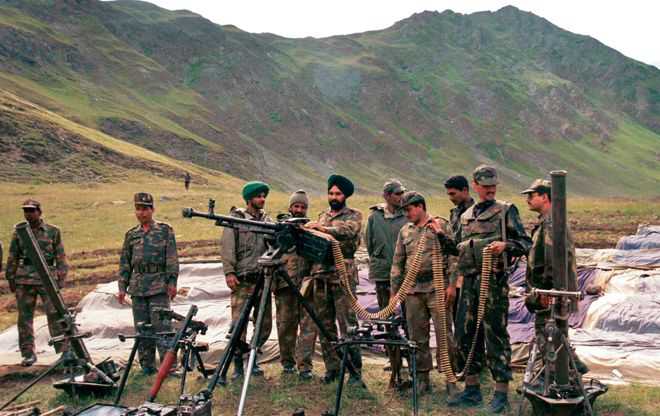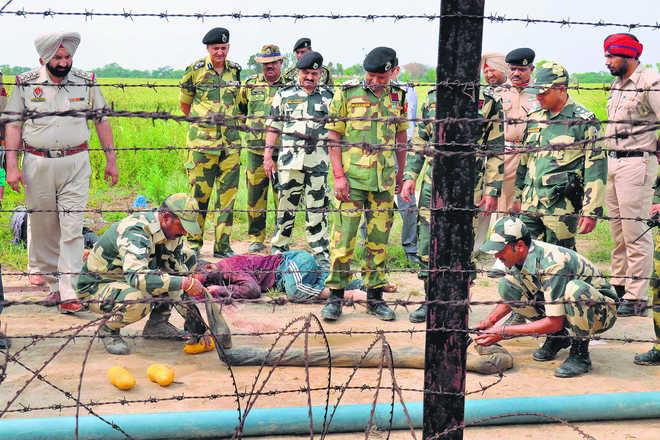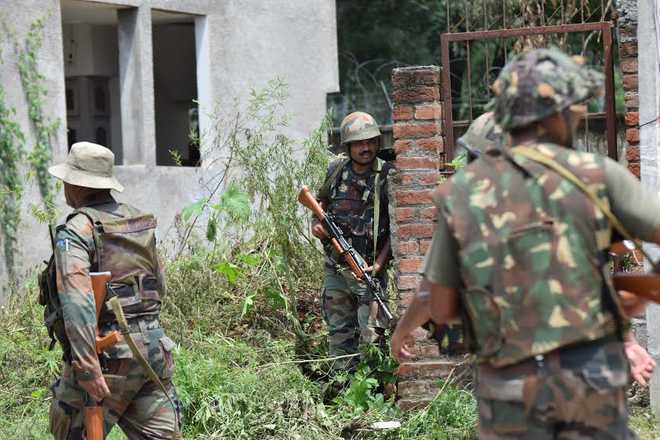Kargil was a blend of military, political and diplomatic victory. We worked in a synchronised manner.
The geo-strategy has changed in last 20 years. There is a visible proactive stance being adopted today at the political level. India has absolutely called Pakistan’s nuclear bluff. We have raised the threshold. To remain at that level, we have to be better prepared and improve our defences and offensive capabilities.
›
The understanding between the civil and military authorities has not come about so far as the jointmanship was envisaged by the Kargil Review Committee. The chief of defence staff has not happened even after it was accepted by the cabinet years ago. This is affecting our military strategy doctrine. The services are fighting their own turf wars.
From page 01 In the roller coaster history of India-Pakistan relations, 1999 stands out as the year when the separated-at-birth neighbours dramatically veered off from hosannas – at an unprecedented carnival of bus diplomacy at Wagah border on a crisp February 18 morning – to hostilities in Kargil just three months later. Twenty years after he, as the then army chief, led India’s war machine, General Ved Prakash Malik, 79, now retired and settled in Panchkula, is full of vivid memories of the 60-day conflict – from the strategy confabulations in New Delhi to his impromptu gesture of gifting whiskey bottles and watches to brave soldiers on ground zero.
■ REMEMBERING KARGIL: Gen Malik (Retd) interacting with HT at his Panchkula residence.A day before he left for Kargil to pay tributes to the fallen soldiers on the July 26 Vijay Divas, Gen Malik, admired for his military scholarship and geniality, spoke to Executive Editor Ramesh Vinayak on the Kargil war, the lessons learnt and their impact on India’s military doctrine. Excerpts:
How do you reflect on Kargil after 20 years?
It is a major event in the history of the country and that of the armed forces. Going through the war was both a privilege and an honour. The fact that at the end of it we were able to change that adverse situation into a victory gives you a lot of satisfaction. You remember the people who sacrificed their lives in fighting but we were to able to achieve the political objective and teach Pakistan a lesson. Since then, they (Pakistan) haven’t dared to do something like Kargil again.
As a limited conventional war, how did the Kargil conflict impact India’s defence doctrine?
At that time, many people, definitely in Pakistan, thought that after the neighbours became nuclearequipped nations, conventional war is not possible and that both have to become responsible. In fact, that is what led to the Lahore Declaration in February 1999. But after the Kargil war, it became evident that there is space below the nuclear threshold. We may not go for an all-out war but a limited conventional war is possible. That was a big lesson. Now both India and Pakistan are quite prepared to fight — I hope they don’t — but that has come into our doctrine.
Is India better prepared now ?
Definitely. The geo-politics and geostrategic dynamics keep changing. In 1990, we shifted 8th Division from this area (Kargil) to Kashmir, which had flared up. Another brigade was moved to the Valley. That left a void. The distance between the forward posts on the Kargil-Drass axis was long. That is what Pakistan was able to exploit in 1990. The first thing we did after the war was to plug those gaps. The 8 Mountain Division that had participated in the war is still deployed in that area. The density of troops has now gone back to what it used to be before 1990, and the gaps are smaller. Post-1999, we brought in 14th Corps at Leh to look after the Line of Control (LoC) beyond Zoji La to Siachen, relieving the Srinagarbased 15th Corps, which has been engaged on the anti-insurgency grid. There has been a major shift in command and control of that area. Third, and most importantly, our weapons and equipment, particularly the surveillance stuff, has improved. Today, we have all kinds of radar, UAVs and gadgetry. The road network and accommodation for troops in snowbound areas has become better.
Does Pakistan still have the potential to spring a nasty surprise?
The potential is there. But will they dare to do it? I don’t think so. Pakistan knows India’s response will be heavier and stronger.
There has been a lingering debate on the high toll of 527 men that the Indian Army suffered to regain our own territory.
That was the result of two factors. One, the political objective given to the armed forces was to throw the Pakistani intruders out of the area without crossing the LoC. There was no question of capturing their territory. To undo what Pakistan had done, we faced challenges such as a difficult terrain, lack of intelligence and poor surveillance. There were shortages all over. Quite a high number of casualties were suffered between May 5, when the intrusions were first detected in Batalik, and May 21. That was because initially the intruders holding the high features on our side of the LoC were thought to be ‘mujahidins’ ( militants). So, the troops which were hastily moved in and tasked to push them back followed the same tactics and rules of engagements that they generally do in anti-militancy operations in the Valley. It was only afterwards when I started questioning the identity of intruders that it became evident to us on May 22 that they were Pakistani regulars. That is when I briefed the Cabinet Committee on Security that we were up not against militants but the enemy and said that all three of us (the army, air force and navy) need to operate together. Then the whole thing changed. Despite those challenges, we were able to recapture the area without crossing the LoC. That itself was an achievement. The circumstances of war were such that we suffered high casualties.
But, Pakistan did succeed in putting Kashmir in the international limelight, a key objective behind the Kargil gambit.
That was one of the objectives. The other was Siachen. Ever since we captured and occupied the glacier in 1984, General Pervez Musharraf (Pakistan army chief in 1999) had been involved in that. As a brigadier, he had tried to capture some of the posts that are with us, and failed. Siachen has always been a thorn on their side. It has been a psychological drain for the Pakistan army all along. They wanted to interdict the road going from Srinagar to Kargil and Siachen. Pakistan’s gameplan was to give a fillip to militancy that had subsided substantially in 1998.
What was the turning point in Kargil?
The capture of Tololing in the second and third week of June was the breakthrough as this hill feature dominates the Srinagar-Kargil road. Then, we took Point 5140 on the same ridgeline where Captain Vikram Batra did a good job. It was followed by the capture of Point 5203 in Batalik . After that we never looked back. When Tiger Hill and Point 4857 were captured in the first week of July, that was the beginning of the end for the Pakistanis. They fell like nine pins.
How did New Delhi’s behind-the-scene diplomatic push help?
Kargil was a blend of military, political and diplomatic victory. We worked in a synchronised manner. At one stage, I told Prime Minister Atal Bihari Vajpayee, ‘suppose if we can’t undo the intrusion here, then we will have to go across elsewhere. What will be your answer? ’ He understood that. Soon after, national security adviser Brajesh Mishra told TV channels that ‘not crossing the border holds good today, we don’t know about tomorrow’. In the meantime, our military strategy was unfolding on other fronts with the deployment of the infantry and strike formations on the rest of the western border. The navy had moved its fleet in the Arabian Sea. The air force had also taken action. When Mishra met his American counterpart, Sandy Berger, in Paris in the middle of June, he bluntly told him, “Look, we can’t keep our armed forces on the least anymore.” Berger took that message to then US President Bill Clinton. (The then) Pakistan prime minister Nawaz Sharif first visited China but failed to get any support. He was in a panic mode when he travelled to the US and met Clinton on July 4. That very day, our army had captured Tiger Hill. The writing was on the wall.
In hindsight, how prudent was it to not to cross the LoC or international border?
Let’s not forget that after the 1998 nuclear tests, India was in the doghouse. There were global sanctions against us. That was the primary reason why the political leadership told us: ‘Don’t cross the LoC’. But, if we had not been able to succeed the way we did, then we may have got permission to go across. The second handicap was that there was shortage of equipment. The sanctions did not permit us to procure it from abroad.
But all that has changed after India’s surgical strikes and the Balakote bombing.
That is because the geo-strategy has changed in 20 years. There is a visible proactive stance being adopted today at the political level. India has absolutely called Pakistan’s nuclear bluff. We have raised the threshold. To remain at that level, we have to be better prepared and improve our defences and offensive capabilities. You can’t take 40 or 50 casualties in one stroke. After all, the political leadership is questioned by the people who have elected them. This is what happened after Pulwama.
After Kargil, you rued the lack of strategic culture in the country. Has that changed?
Not much. Over the years, there is a slightly better understanding in the public mind, thanks to the media. The political authority now knows that it will be questioned seriously over security issues. But, overall , the culture has not changed because we still have not got the kind of rapport that should be there between the political and military authorities. To be able to live up to that culture, you need greater understanding at the top level, which is not there even today. Policy-makers are more bureaucrats than the military people. We need a greater dialogue with each other and should be prepared so that we don’t get surprised when something like Kargil happens.
The Kargil Review Committee, led by K Subrahmanyam, had made a slew of recommendations. What about their implementation?
Many of them have been implemented but not in the spirit in which they were recommended. The understanding between the civil and military authorities has not come about so far as the jointmanship was envisaged. Certain important recommendations remain unimplemented. For example, the chief of defence staff (CDS) has not happened even after it was accepted by the cabinet years ago. This is affecting our military strategy doctrine. The services are fighting their own turf wars. They didn’t integrate the ministry of defence. The atmosphere in the ministry continues to be civil versus military. That trust is lacking. That’s why there are problems when it comes to the management of the army and the budget.
What are the most important lessons from Kargil?
You can never predict when there will be a war. The nation has to be prepared to fight always. For national security, you have to have your own weapon systems without being dependent entirely on foreign countries. That is why the push to make in India. But it has still not taken off even five years after the government decided to bring in the private sector in defence manufacturing. There is lethargy and nexus in the ministry of defence, between ordnance factories and public sector undertakings. I wish these things become faster. The budget is also not enough. Suddenly, you find that the defence budget has been going up by 5% to 7% every year because of the gross domestic product (GDP). But, as per the share of the GDP, it has not really gone up. The revenue budget has spiked due to increase in pays and one rank one pension (OROP). So, the budget for modernisation and capital expenditure has got reduced. That is not giving the right message to manufacturers. The defence industry requires a lot of investment. These imbalances need to be corrected.
What is your searing memory of Kargil?
It is a mix of happy and sad memories. The most important thing for me was going to the front. In South Block, whether I was meeting politicians or bureaucrats or my colleagues, I found long faces. There were questions and ‘hoga ki nahin hoga (will it, won’t it) ’ kind of mood. The morale was brittle initially. But every time I went to the war zone, almost every sixth day, I never saw that kind of mood. Despite casualties, the morale was high. My officers would tell me, “Don’t worry sir, we will do it.” The positive attitude, the bravery and sacrifices I saw there raised my morale. I came back more confident that we will beat Pakistan. The other memory is about meeting young soldiers, many of who are no more. I remember patting Capt Vikram Batra and giving him a bottle of scotch after he captured Point 5140. A few days later, he made the supreme sacrifice that earned him the Param Vir Chakra.






























































